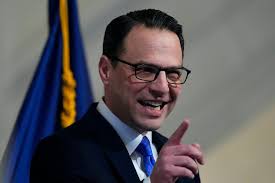Pennsylvania Governor Josh Shapiro has proposed raising the state’s minimum wage to $15 per hour, a move that has sparked mixed reactions among students at Indiana University of Pennsylvania (IUP) and the wider public. While the proposal aims to provide financial stability to low-wage workers, concerns remain about its impact on small businesses and the rising cost of living.
Pennsylvania’s Minimum Wage Lagging Behind
Pennsylvania’s minimum wage has remained stagnant at $7.25 per hour since 2009, falling behind many neighboring states. In his budget address on February 6, Shapiro emphasized the need for an increase, stating that Pennsylvania is losing its competitive edge in the job market.
On March 19, he posted on social media:
“Every single one of our neighbors has raised their minimum wage. It’s time to catch up — let’s raise the minimum wage to $15 an hour.”
His statement received mixed reactions online, with some supporting the change and others worried about potential drawbacks.
How Does Pennsylvania Compare to Other States?
Currently, 31 states have set minimum wages higher than the federal rate of $7.25. Washington, D.C. leads with a minimum wage of $17.50, while states like California and New York have also adopted significantly higher wage standards.
In contrast, five states—Alabama, Louisiana, Mississippi, South Carolina, and Tennessee—do not have state-set minimum wages and follow the federal standard of $7.25 per hour.
Support and Opposition to the Proposal
Supporters of the wage increase, including Democratic Representative Roni Green, argue that the current minimum wage is outdated and insufficient. Green stated:
“$7.25 wasn’t enough 15 years ago and it’s absolutely not enough now. Like Gov. Shapiro said, it’s time to give more than one million Pennsylvania workers a raise.”
On the other hand, opponents—mainly small business owners and economic analysts—worry that a sudden jump to $15 per hour could harm businesses, leading to layoffs, reduced hiring, and higher consumer prices.
How Would This Affect University Students?
The proposed wage increase could significantly impact students, both positively and negatively.
Potential Benefits for Students
- A higher minimum wage would provide financial relief to students who work part-time jobs, helping them afford tuition, rent, and daily expenses.
- Increased wages could reduce the need for student loans, leading to lower debt after graduation.
Patrick O’Connor, a political science sophomore, welcomed the proposal, stating:
“I think it’s a step in the right direction, especially knowing that neighboring states already have higher wages.”
Possible Drawbacks for Students
- Higher wages may make employment more attractive than education, leading some students to prioritize work over studies.
- Universities could face budget constraints, as they may need to increase wages for student workers.
- Small businesses near campuses might struggle with higher labor costs, potentially reducing available job opportunities.
Alexis Bardos, a sophomore majoring in biology and psychology, believes the increase is too drastic:
“The jump from $7.25 to $15 is too large for Pennsylvania to move to in such a short amount of time. A gradual increase, like the $9.50 proposal in 2019, would be more manageable.”
What’s Next for the Proposal?
Gov. Shapiro’s proposal is currently awaiting approval from the Pennsylvania Senate after passing in the state’s House. If approved, Pennsylvania will begin implementing the $15 minimum wage.
Many states have adopted a phased approach, gradually increasing wages over several years. If Pennsylvania follows this model, it could help businesses and employees adjust more smoothly.
Conclusion
Gov. Shapiro’s plan to raise the minimum wage aims to strengthen Pennsylvania’s workforce, improve economic fairness, and boost consumer spending. While the proposal offers significant benefits, concerns about its impact on small businesses and universities remain.
For now, students, workers, and business owners alike are watching closely as the state legislature debates the future of Pennsylvania’s minimum wage.
Disclaimer – Our team has carefully fact-checked this article to make sure it’s accurate and free from any misinformation. We’re dedicated to keeping our content honest and reliable for our readers.

